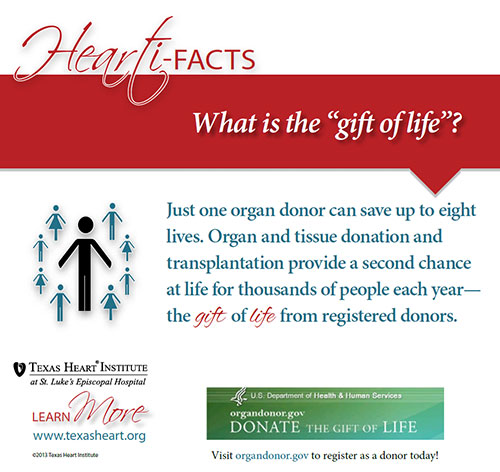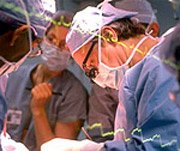Introduction
The first heart transplants were performed in the late 1960s. But it was not until the use of anti-rejection medicines in the 1980s that the procedure became an accepted operation. Today, heart transplantation provides hope for a select group of patients who would otherwise die of heart failure.
Established in 1982, the transplant program at the Texas Heart Institute at CHI St. Luke's Health - Baylor St. Luke's Medical Center is one of the most experienced, successful programs in the world. Its surgeons have performed more than 1,300 transplant procedures. The key to the program's success is an experienced, highly skilled transplant team that includes surgeons, cardiologists, nurses, operating room personnel, social workers, psychologists, dietitians, rehabilitation specialists, and many other professionals. The team works to meet every need faced by transplant candidates, including emotional, family, and financial needs.
Reasons for Transplantation
The need for a heart transplant can be traced to one of many heart problems, each of which causes damage to the heart muscle. The two most common heart problems are coronary artery disease (the buildup of plaque in the arteries of the heart) and idiopathic cardiomyopathy (disease of the heart muscle without a known cause).
As the heart problem gets worse, the heart grows weaker and is less able to pump oxygen-rich blood to the rest of the body. Because the heart must work harder to pump blood through the body, it tries to make up for this extra work by becoming enlarged (hypertrophied). In time, the heart works so hard to pump blood that it may simply "wear out," and be unable to meet even the smallest pumping demands. Medicines, mechanical devices to assist the heart, and other therapies (including stem cell therapy) can sometimes help and even improve a patient's condition. But when those treatments fail, transplantation becomes the only option.
The First Step Toward Transplantation
In most cases, your personal doctor will make the first inquiry about a transplant. Doctors who contact a transplant team will talk about your medical history, current condition, physical abilities, test results, and other important information. Your doctors will be asked to send your records to the transplant team so they can carefully review your medical history. You must then have a complete evaluation to find out how severe your condition is and whether other therapies may help you.
The transplant candidates who have the best results are younger than 60 years old and have no serious medical problems other than those with their heart. Patients older than 60 are considered for transplant on an individual basis.
The Financial Challenge
Even if you meet the medical requirements for heart transplantation, a large financial hurdle still looms ahead. A heart transplant is an expensive procedure. Medicare and many private insurers cover heart transplantation, so some families do not have to worry about how they will pay for the surgery. Other people must use their own money to pay for their transplant. With the help of hospital social workers, financial officers, and other professionals, patients without the insurance or savings they need may be able to find other sources of funding. Even so, the final responsibility for the cost of a transplant rests with the patient and the patient's family.
Waiting for a New Heart
Once you are accepted into a transplant program, the wait for a new heart begins. A number of factors determine your place on the waiting list for a donor heart. These factors include blood type, size match between you and the donor, your medical condition, and how long you are able to wait for a new heart. The order of the waiting list can change. Sometimes, patients improve enough from other treatments to be taken off the list. Other patients may become sicker, so they move higher on the list.
The use of left ventricular assist devices has reduced the urgency of some patients' wait for a donor heart. These devices are connected to the heart during an operation. They help the heart to pump (giving it time to rest) until a healthy heart can be transplanted. Some of these devices can keep patients alive for many months, while greatly improving their quality of life and overall health. In some cases, just resting your heart can improve its condition enough to keep you from needing a transplant.
The Law of Supply and Demand
Many patients find that waiting for a donor heart is the hardest part of the transplantation process. Nobody can tell you when the call will come or how long the wait will be. Sadly, this part of the process falls outside of human control.
The demand for donor hearts is greater than the supply. At any given time, more than 3,000 patients are on the national patient waiting list for a heart transplant, but only about 2,000 donor hearts become available for transplantation in a year. In the United States, the United Network for Organ Sharing (UNOS) determines priority for a heart transplant by grouping patients by the severity of their heart condition. This grouping lets those who need a transplant most be considered first. The groupings are as follows:
- Status 1A – includes very ill patients who need constant inotropic medicines or mechanical assistance (left ventricular assist devices); these patients are expected to live less than one month without a transplant.
- Status 1B – includes medically stable patients who need constant inotropic medicines or mechanical assistance (left ventricular assist devices); these patients are expected to live more than one month without a transplant.
- Status 2 – All patients who do not meet the above standards.
What is "The Gift of Life"?

|
Donor hearts usually come from people who have died of injuries that have spared the heart. Matching these donors with transplant candidates can be difficult. First, trauma patients must be quickly taken to hospitals and identified as donors. The hospital must have approval to remove the donor heart. Medical and laboratory tests are needed to find out the condition of the donor heart and the donor's blood type. When a donor and a candidate are in different parts of the country, it becomes a race against time. A donor heart cannot safely be outside of the body for more than four hours. In the United States, 246 UNOS-approved heart transplant programs work together to make sure that every donor heart that can be used is used.
The Wait Ends
You must wear a beeper at all times to make sure that you know right away if a donor heart is found. Once you receive the long-awaited news, time is very important. You must have a final evaluation and laboratory work-up at the hospital before going into the operating room. If there are no complications, a transplant operation takes about 3 hours to complete.
After transplant, you will spend 1 or 2 days in the recovery room, 2 or 3 days in the intensive care unit, and about 7 days in a private room in the transplant unit. During this time, you will undergo constant monitoring and testing, including regular heart biopsy procedures. A heart biopsy involves removing small pieces of tissue from your new heart to see if your body is rejecting the organ. For a 3-month period after leaving the hospital, you must go back to the hospital for regular checkups. These checkups let members of the transplant team watch you closely for signs of rejection or other complications.
Although most transplants are successful, some do not turn out as hoped. In some cases, the donated heart simply does not work. This is called "graft failure," and it becomes obvious in the operating room or shortly after surgery. Another major cause of failure is "tissue rejection." The body's immune system knows that the donated heart is foreign tissue and tries to destroy it, as if it were a virus or some other disease-causing agent. There is no other way to check for signs of rejection, except through routine biopsy of heart tissue.
Transplant recipients have an increased risk of infection, especially during the first 3 months after transplantation, because of the medicines they must take to prevent rejection. These medicines, called immunosuppressants, make it harder for the body to fight off disease. Sometimes these medicines can let an infection turn into a serious medical problem long after surgery.
Return to Normal Living
With the proper care and by following the advice of your doctor, patients who are fortunate enough to receive a donor heart can look forward to a full and productive life.
See also on this site:

See on other sites:
MedlinePlus
https://medlineplus.gov/hearttransplantation.html
Heart Transplantation
https://medlineplus.gov/organdonation.html Organ Donation
U.S. Department of Health & Human Services
organdonor.gov/
Donate the gift of life.
United Network for Organ Sharing
www.unos.org/
Working together. Saving lives.
Updated August 2016



